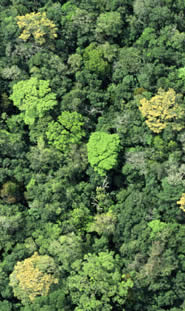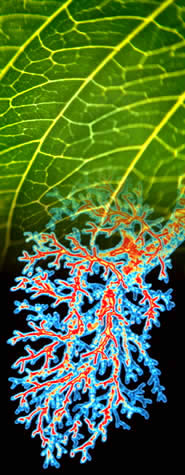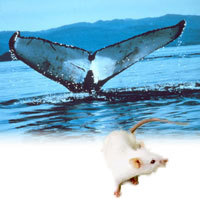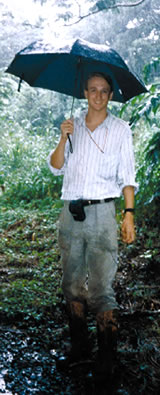
All creatures great and smallThe living world is governed by laws based on fractal geometry and on the sizes of organisms, some scientists claim. John Whitfield looks at the debate surrounding a biological 'theory of everything'.27 September 2001
Some people see only the trees, others the whole wood. But when Brian Enquist enters one of his Costa Rican field sites, he senses far deeper patterns. "When I walk into the forest, I have the feeling that, although it's very complex, there are simple rules underlying that complexity," he says. Enquist, an ecologist at the University of Arizona in Tucson, is working to derive laws that can explain the workings of ecosystems, and the biology of their constituent organisms, in terms of those organisms' sizes - a project "as potentially important to biology as Newton's contributions are to physics", as one commentator recently put it1. By explaining simple scaling laws - mathematical expressions of how organisms' biology varies with their size - in terms of the fractal geometry of networks such as circulatory systems, Enquist and his colleagues hope to understand patterns in metabolism, growth, ecology and evolution right across the living world. A string of highly cited papers in top journals, and the Ecological Society of America's 2001 Mercer Award for young investigators, to Enquist, attest to the impact of these ideas. But, as with any bold new theory, some question its generality, and others its truth. Other critics even deny the existence of the very trends that the theory seeks to explain. Have Enquist and his colleagues really made a stunning theoretical breakthrough, or is the comparison with Newton hype? The debate rages, but whatever consensus eventually emerges, just about everyone involved believes that important biological insights will stem from this new focus on scaling. Scale model In attempting to derive a fundamental explanation for biological scaling laws, Enquist and his two associates - ecologist James Brown of the University of New Mexico in Alberquerque, and physicist Geoffrey West of Los Alamos National Laboratory, also in New Mexico - have reopened the files on a mystery that has baffled biologists for more than half a century. Naturalists have long known that many aspects of organisms' biology vary with their size. Bigger animals live at a slower pace. They survive longer, grow more slowly, have slower heart rates, and so on. In the 1930s, physiologist Max Kleiber of the University of California, Davis, put a number on this trend. He showed that an animal's metabolic rate is proportional to its body mass raised to the power of 3/42. This relationship has been found to hold across the living world from bacteria to blue whales and giant redwoods, over more than 20 orders of magnitude difference in size. Scaling laws based on exponents in which the denominator is a multiple of four apply to a host of other biological variables, such as lifespan. "There's maybe 200 scaling laws that have quarter powers in them," says West.
But for decades, scaling laws stubbornly resisted explanation. Organisms are three-dimensional. So, from the principles of euclidean geometry, one might expect that biological scaling laws would operate on multiples of the third, rather than the quarter power. Metabolic rates, for instance, might scale as the 2/3 power of body mass - this is how body surface area, where metabolic heat is lost, scales with its volume, which determines how much metabolic heat a given organism can produce. In the mid-1990s, Enquist and Brown began to search for factors that might explain the 'missing' fourth dimension of biological scaling. They suspected that the dynamics of organisms' internal transport of nutrients and other resources might provide the key. Through contacts made at the Santa Fe Institute in New Mexico, which specializes in thorny cross-disciplinary problems, they teamed up with West, a theoretical physicist with the mathematical expertise to help them develop the idea. The resulting theory frames the scaling conundrum in terms of resource-distribution networks, such as blood vessels, the xylem that transports water through plants and the tracheal tubes that carry oxygen to an insect's tissues. Thus, variables such as metabolic rate - and the effect on them of changing body size - become a consequence of how resources are shunted around these networks.
West, Brown and Enquist's theory starts with the assumption that evolution has made biological resource-distribution networks maximize the area across which they can take up and release resources and minimize the time and energy needed to transport those resources through the organism. "Natural selection is very powerful," says Brown. "It's difficult for organisms to deviate from the optimum." The model also assumes that the size of networks' terminal units is independent of body size - that a mouse's capillaries, say, are the same size as those of an elephant. Networks that fulfil these criteria turn out to have fractal geometry, argue West, Brown and Enquist. This means that their branching structure can be described mathematically by applying a simple mathematical formula over and over again. Abandoning Euclid and embracing fractals was the key step, says Brown. "Much of life is designed in a fractal-like way. We were able to make that cogent and relevant by developing rigorous quantitative models." This fractality seems to solve the enduring puzzle of why the scaling exponents of three-dimensional organisms are multiples of the number four. Filling a three dimensional volume with a network that maximizes the two-dimensional surface area available for capturing and releasing resources creates a four-dimensional geometric entity3. This is difficult to visualize, but Enquist uses the analogy of how a tree uses three-dimensional space to cram a much larger area of essentially two-dimensional leaves into the ground space covered by its canopy. "Fractal geometry kicks life up to another dimension," he concludes. In April 1997, West, Brown and Enquist unveiled their theory by showing that they could derive Kleiber's 3/4-power scaling law linking body mass and metabolic rate4. Under fire The researchers have since used the theory to describe a range of biological phenomena, such as scaling and structure in vascular plants5. They have also expanded their thinking from the level of individual organisms to entire ecosystems. Using their models describing the relationship between body mass and metabolic rate, for instance, the researchers have shown that - wherever resources such as nutrients or water are a limiting factor - the population density of trees scales to the -3/4 power of each individual's mass6. The rule seems to hold for forests from the Amazon to the Arctic7. The same theoretical framework also explains why, regardless of the speed at which plants' diameter or height increases, their growth rate scales to the 3/4 power of their body mass8. According to this view, different plant life histories, encompassing vastly different rates of growth and timings of sexual maturity, simply represent different ways of following the same law for optimal energy use9.
So have West, Brown and Enquist derived biology's 'theory of everything'? Enquist sees their current ideas as "an excellent first approximation" of an eventual general explanation of resource use by organisms. But the theory has come under fire from some researchers who question its initial assumptions, and from others who believe that biological reality has been lost in the quest for generality. Earlier this year, a group of physicists at the Massachusetts Institute of Technology questioned the very existence of the 3/4 law for mass and metabolic rate. Re-analysing published data sets dating back to Kleiber's original, Peter Dodds and his colleagues concluded that the exponents in most of them were statistically indistinguishable from 2/310. "The original data on metabolism don't really bear out the prevailing idea that it's a 3/4 exponent - you get all sorts of scalings," claims Dodds, who now works at New York's Columbia University. Faced with a cloud of decimal places from different studies, earlier generations of biologists fudged on 3/4, partly because it made their slide-rule calculations easier, Dodds suggests. Brown denies that the numbers aren't up to scratch. "Metabolic rate is not difficult to measure," he says. "And whenever we have a reasonable number of measurements, they all cluster about 3/4." William Calder, an ecologist at the University of Arizona, says that the large number of biological variables with 3/4-power scaling confirms the trend. "It all hangs together," he says.
Biologists working on fine details of the biology of particular organisms have criticized the fractal theory's attempts at generality. Although most agree that the cross-species correlations look good overall, many individual species deviate widely from the scaling rules. "The more detail that one knows about the particular physiology involved, the less plausible these explanations become," says Henry Horn of Princeton University in New Jersey, a botanist who studies patterns of tree growth. "I have a tendency to think that nature does different things in different ways." But criticism based on the observation that individual species disobey scaling laws misses the point, says West. The theory is designed to capture laws true for an idealized average organism, rather than every individual plant and animal. West says that in fact he expected to find that many more species deviated from the theory's predictions. "What I find most mysterious is why in hell does it work so well? It's a little bit frightening." West puts much of the disagreement down to a cultural difference between physicists and biologists. "If Galileo were a biologist, he would have written a big fat tome on the details of how different objects fall at different rates," he says. Enquist agrees. "Biologists tend to lack a philosophical bent to look for generalities," he says. Branching out But growing numbers of biologists are now gravitating towards the new theoretical framework. "I've gone from being an atheist to an agnostic," says botanist Karl Niklas of Cornell University in Ithaca, New York. Niklas, the author of the newtonian comparison, now collaborates with Enquist. If the theory holds up, he says, it has "the potential to explain virtually everything" that relates to organisms' sizes. Another enthusiast, ecologist Mark Ritchie of Utah State University in Logan, has adapted the theory to explain how animals of different sizes share out the resources in an ecosystem. He has modelled communities of foraging animals as a fractal network of resource exploitation. From this, he has predicted how many species can coexist in a particular place - in other words, he is trying to explain biodiversity from fundamental principles. The model gives a good fit to the patterns of species richness seen on the Serengeti and the Minnesota prairie11. In unpublished work, Ritchie has moved on to looking at how the area of an animal's home range scales with body mass. For carnivores, he has found that the amount of land needed rises sharply with increasing body size, because their prey is relatively rare. This makes predators especially vulnerable to habitat fragmentation. Even critics such as Horn do not argue with the data that West, Brown and Enquist are producing. "The relationships are so tight that there have to be some very powerful generalizations behind the mechanics," he says. But Horn doubts the significance of fractal geometry. Although trees look like fractals, he says, their growth is more complicated than the iteration of mathematical formulas, involving a complex balance between tissue formation and death.
Jayanth Banavar, a theoretical physicist at Pennsylvania State University in University Park, believes biological generalizations can be explained without resorting to fractals. Two years ago, Banavar and his colleagues published a simpler model, which argued that Kleiber's 3/4 rule is a consequence of any network in which resources flow outward from a source to their uptake sites12. Considering the total length of the network, the number of sites at which resources can leave it, and the total amount of resources in the network at any one time, they argued that the 3/4 rule falls naturally from the calculations. "The three-quarters is inherently built into any directed network - you don't need fractality, or optimality, or anything," says Banavar. But many experts on scaling are sceptical of Banavar's approach - including those who are critical of West, Brown and Enquist. West adds that Banavar's theory does not explain the wide variety of scaling phenomena embraced by the fractal theory. "It's not correct," he claims. "And even if it was correct it only explains one piece - the metabolic rate."
Meanwhile, like a fractal, West, Brown and Enquist's theory is branching out in all directions. "We were aware that we'd uncovered the tip of an iceberg," says Brown, "but not how big it was and where it might lead." Brown, Enquist, West and their collaborators now have their sights set on a mind-boggling range of problems. They believe that scaling laws can be applied to the molecules and subcellular organelles involved in respiration and cell division. A paper co-authored by Brown and published last week includes trends in body temperature - the next most important biological property after size, says Brown - in the theory13. Eventually, he hopes to explain relationships between temperature, body size and rates of evolutionary change. Brown is also intrigued that animal cells grown in a culture dish increase their metabolic rate and rate of division - as if they were aware of no longer being part of a massive unit. The same goes for cancer cells, which have rebelled against the larger unit. He is similarly fascinated by the observation that cancer cells can modify resource- distribution networks, stimulating blood vessel growth. Whether West, Brown and Enquist have hit the nail on the head with their fractal approach, Niklas is convinced that simple and general rules governing diverse biological phenomena lie waiting to be discovered. "I don't think that the ecological patterns that we see surfacing in fossils and living organisms and across the continents are a consequence of chance," he concludes. |
||||||||||||||||||||||||||||||||
|
References
| ||||||||||||||||||||||||||||||||
|
|



